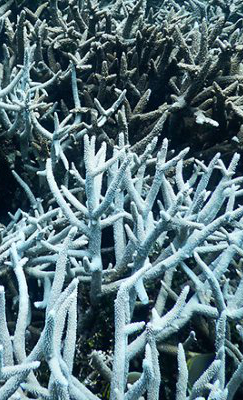Bleaching reaches deeper reefs
 Bleached sea sponges have been found in deeper reefs off Tasmania.
Bleached sea sponges have been found in deeper reefs off Tasmania.
A new study has found bleaching in sea sponges for the first time in Tasmanian waters.
It may be an early warning sign of thermal stress from marine heat waves in the region, the new Institute for Marine and Antarctic Studies (IMAS) study reports.
While impacts like die-offs and bleaching are widely reported in coral reefs and other shallower ecosystems the study, published in Climate Change Ecology and supported by Parks Australia, goes deeper into the mesophotic zone.
Here in the twilight zone between the familiar well lit, shallow waters and the darkness of the deep ocean, communities of corals, sponges and red algae are dominant on rocky reefs.
They provide structural habitat and play an important role in the ecology of our oceans, concentrating passing food sources to support important offshore fisheries such as rock lobster and striped trumpeter.
“Understanding how marine heat waves and other extreme climate events are impacting ecosystems at those depths is a costly exercise but so important, particularly in our region which is considered to be a global ‘hotspot’ for marine climate change,” lead author and IMAS researcher Dr Nick Perkins said.
IMAS researchers used benthic imagery to explore bleaching in easily-identified cup sponge species (morphospecies).
This was collected using autonomous underwater vehicles provided by the Integrated Marine Observing System (IMOS) as part of a large-scale monitoring program across eastern Tasmania, including within Flinders, Freycinet and Huon Marine Parks.
“Bleaching is well known in tropical corals and has been noted to occur in sponges in shallower tropical waters, but our study shows bleaching can also occur in deeper temperate water sponges,” Dr Perkins said.
“We found an increased occurrence of sponge bleaching following marine heat waves across the region, but currently no evidence of mass mortality following bleaching.
“Our surveys also revealed that the symbiotic algae found in these temperate ‘twilight’ zones may be sensitive to warming or be expelled by heat-stressed sponges.”
IMAS Assoc Prof Neville Barrett, who leads the IMOS-supported seabed monitoring program in Tasmania, says the findings of the study are important from a conservation perspective.
“These deeper reefs are known to be biodiverse zones and could contain species not yet described by science. We still know very little about these systems below diving depths – how they function and how they may respond to climate change,” Assoc Prof Barrett said.
“The cup sponge morphospecies is widespread and relatively abundant, and can be reliably identified in imagery, which makes it useful for tracking the impacts of climate change in our region.”
The study recommends ongoing research to establish the threshold temperatures and the length of exposure to warming for bleaching to occur, and to determine how long bleaching persists, and how these factors differ across this cup sponge morphospecies’ spatial range.








 Print
Print